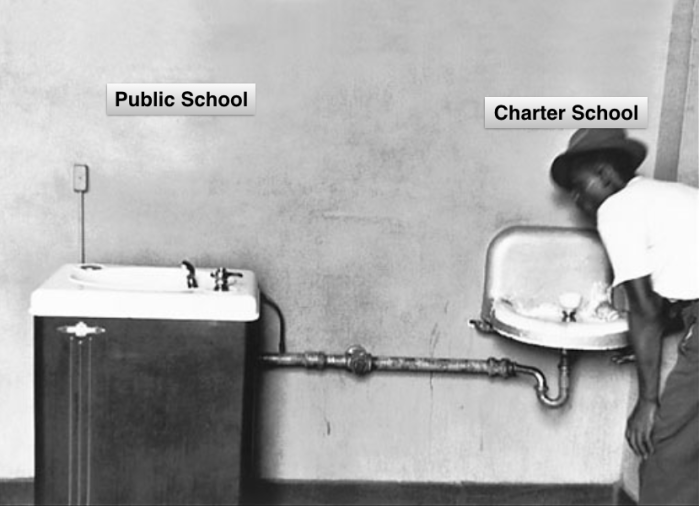Failing the Test: A New Series Examines Charter Schools - CAPITAL & MAIN:
Failing the Test: A New Series Examines Charter Schools
Illustration by Manoel Magalhaes
When the Great Public Schools Now Initiative, the $490 million blueprint to turn half of Los Angeles’ public school system into charter schools, was first leaked to Los Angeles Times reporter Howard Blume, it triggered an uproar among the city’s education community. The Los Angeles Unified School District already has more charter seats than any school system in the country, though at a lower percentage (about 16 percent) of total enrollment than Oakland’s — which, at roughly 25 percent, is proportionally the state leader. And like Oakland, and many other urban school systems in the U.S., LAUSD is teetering on the brink of bankruptcy.
This comes at a time when charter-supporting philanthropists, led by the Broad, Walton Family and the Bill and Melinda Gates foundations, have been aggressively pushing charter schools across the country under the banner of “parent choice.” The initiative, which originally surfaced with a cover letter signed by Eli Broad and is often referred to as the Broad Plan, argues its case by charging that the country’s “urban school districts are not serving students. This failure is particularly acute for low-income and minority students who are in the greatest need of a quality education.” But contrary to the plan’s claims, the charters’ overall report card has not been so stellar.
According to University of Colorado, Boulder professor Kevin G. Welner and others, charters have been shown to offer no tangible academic advantages over traditional public schools. Welner, who is director of the National Education Policy Center, told Capital & Main, “If we’re talking about test scores, we’re not seeing any real meaningful differences between charter schools as a whole and noncharter public schools.”

Photo by Pandora Young
Today there are about 1,230 charter schools statewide (or seven percent of the state’s K-12 enrollment), with 80 new schools opening in the 2015-16 school year alone, 21 of which were in Northern California. The 27 that opened in Los Angeles put it first in the state for growth. The Great Public Schools Now Initiative calls for 260 more charters to be created in the city by 2023. Capital & Main has since learned that charter groups have also been quietly pushing a similar plan to make Oakland’s school district half charter schools and half traditional schools.
“If you are talking about going to one-third [or] one-half of enrollment in a place like Oakland or L.A., there are two big worries,” says Bruce Fuller, a professor of education and public policy at the University of California, Berkeley. “One is [that] you start to siphon off the most motivated families out of the traditional system and into the charter system. [Then] the charter system starts to look more and more like a network of private schools. So that kind of creaming process is very worrisome. The second thing is their fragile financial situations — especially Oakland’s. As you drain the dollars out of the mainstream system, the traditional system starts to shrink and implode as it tries to compete.”
Kevin Welner, Director, National Education Policy Center: “If we’re talking about test scores, we’re not seeing any real meaningful differences between charter schools as a whole and noncharter public schools.”
These caveats have led some critics to question not only if charter schools represent a viable or effective solution to improving learning opportunities for the state’s most disadvantaged children, but whether reforming public education is the only driver of charter expansion in the state.
Steve Zimmer, the LAUSD school board president, has his doubts. Zimmer, who has been one of the harshest critics of the Broad Plan, points to the charter industry’s pattern of existing expansion in Southern California. The LAUSD’s 130,000 charter-student population already would make it roughly the 20th largest school district in the country. It also, Zimmer says, represents an overpopulated charter school oasis surrounded by a veritable charter-free desert of even more desperate, high-needs districts like Lancaster, Palmdale, Santa Ana, Pasadena, Lynwood and Compton.
“Even if you accepted the argument that choice is the most important lever for change and that charter schools were providing extraordinary opportunity,” he pointed out in an interview, “how could you possibly justify opening a hundred more charter schools — or 10 more charter schools even — in L.A. Unified, when there are districts with lower student outcomes all around L.A. Unified, places where there are no charter schools? The only answer is that it’s not about kids and it’s not about kids who need choice the most. And it’s not even about choice. It’s about what is in LAUSD that’s not in any of these other districts.”
What makes LAUSD a priority target, Zimmer maintained, is its board of education, which has been staunchly supportive of effecting reform within the public school system rather than through privatization, and the influential, 31,000-member United Teachers Los Angeles (UTLA), the second largest teachers union local in the nation.
Zimmer may have a point. In a section on political strategy titled “Improving Conditions for Los Angeles Charters,” the Broad Plan emphasizes its goal of winning a pro-charter majority on the LAUSD school board, and it spells out the effectiveness — and importance — of lobbying by the California Charter School Association to “improve the political and regulatory landscape.”Failing the Test: A New Series Examines Charter Schools - CAPITAL & MAIN:
Big Education Ape: How California's Charter Schools Are Failing The Test - http://go.shr.lc/283bJkr
Coming:
Wednesday
Failing the Test: Charter Schools’ Winners and Losers - CAPITAL & MAIN - http://go.shr.lc/24j3Fr0
Charter Schools’ Winners and Losers, by Capital & Main Staff (with video)
Yardsticks and Rulers: Measuring Charter School Performance, by Julian Vasquez Heilig
ThursdayThe Charter School Movement’s Powerbrokers, by Capital & Main Staff
Who’s Accountable? Searching for Charter School Transparency, by Bobbi Murray
FridaySchool Solutions and Turnarounds, by Bobbi Murray and Bill Raden
Solutions for Struggling Schools: Nine Takeaways, by Julian Vasquez Heilig
Plus video interviews with John Rogers, Director, UCLA Institute for Democracy, Education and Access.



















